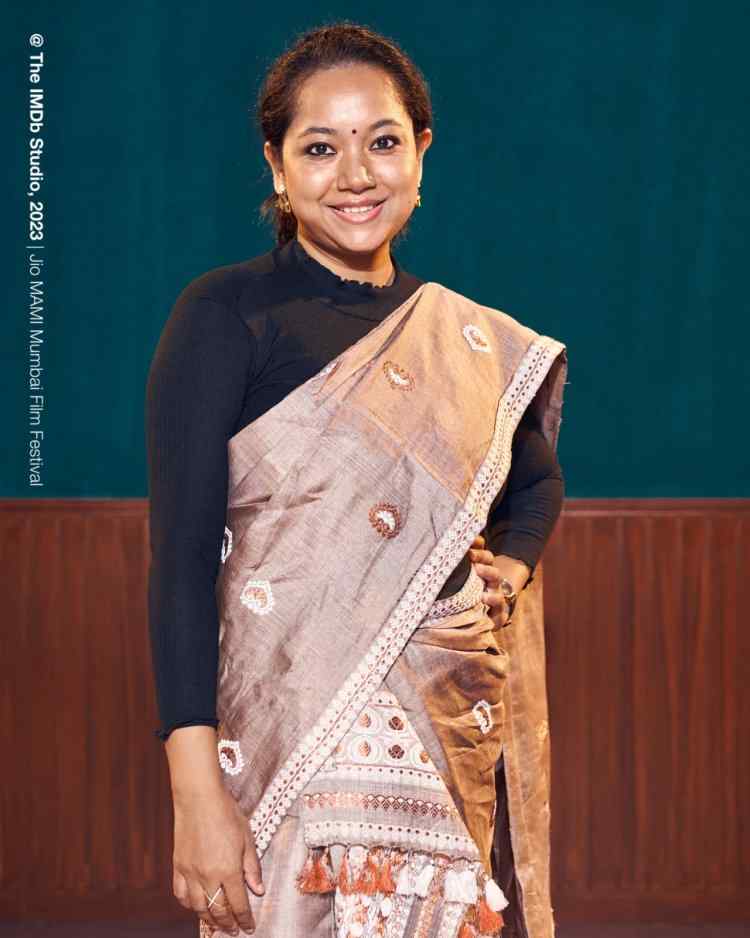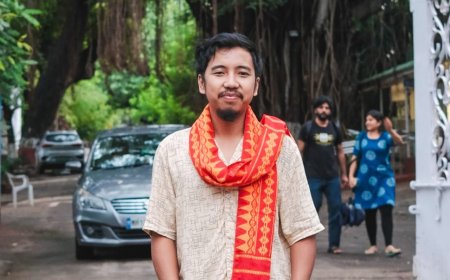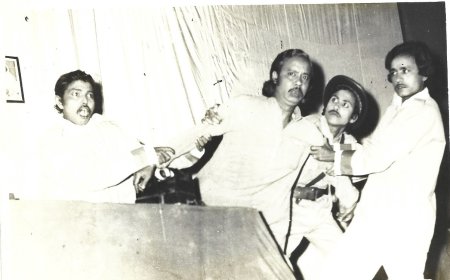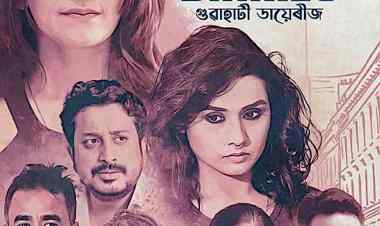In Conversation with Shrutismriti Changkakoti
Dipankar Sarkar is engaging in a discussion with Shrutismriti Changkakoti, the director of the movie 'Before Spring'.

Before Spring (2023), an Assamese film by Shrutismriti Changkakoti unfolds in a quaint village, intricately connected to the city by a serene river. Within this setting, we encounter individuals of various age groups, each navigating unique life journeys and facing internal challenges and struggles. The film exudes a delightful naturalism, presenting events in a manner that feels authentic and grounded. This marks a promising beginning for the filmmaker, showcasing a keen ability to capture the subtleties of human connection and the beauty found in the simplicity of everyday life.
In a candid interview, Changkakoti delves into the intricate journey that unfolded during the making of her first feature with a thoughtful and reflective tone. She opens up about the initial sparks of inspiration, sharing the genesis of the film and the pivotal moments that shaped its narrative contours.
Dipankar Sarkar: Between 2011 and 2023, you shot two short films, one documentary, and one feature film, carving out your journey as a filmmaker. Looking back from today’s perspective, what initially drew you to filmmaking?
Shrutismriti Changkakoti: I have to revisit my childhood days to answer this question. My mother used to sing, and my father was a very supportive partner to her. He would encourage her to pursue her interests and organize cultural evenings during Bihu in April. My younger sister and I would always join these cultural evenings. When my father noticed my interest in drama, he enrolled me in a children’s summer camp where kids from our native place would engage in month-long theatre activities. I became deeply involved in performing plays and also became an active participant in school dramas and dance programs. My parents used to take us to cinema theatres to watch films, attend poetry sessions, and allow us to socialize with the people around us. This period was incredibly beautiful during our formative years.
For many years, up until my first year of post-graduation, I was keen on pursuing theatre direction and acting. However, in the second year of my post-graduation, I developed a profound connection to the captivating world of cinema. I began watching more world cinema, eventually leading me to enroll in an introductory film appreciation course provided by the Film and Television Institute of India (FTII). I relocated to Mumbai in 2011 and started working as an assistant director in a few films and advertisements. Although I wasn't entirely happy about my assistant days and, at times, felt left out, those days on the sets taught me a lot of practical know-how. I also worked in a few prominent media houses in Mumbai as a film and program producer.
To begin with, I started shooting my short films and, much later, a documentary film during my stay in Kolkata. I believe that my soulful childhood memories, my parents' unwavering support in finding my way, and my experiences with short films and documentaries were the stepping stones to the making of my first feature film.
DS: What was the motivation behind making a feature film about ordinary people living in a small town as your debut? How did this project start?
SC: When I decided to direct my first feature film, my thoughts naturally gravitated towards the people of my native village—their nuances, anecdotes, the river serving not only as a mode of transportation but also as a silent spectator, the geography, and myself as that little girl traversing through all the memory lanes.
I spent my entire childhood in my native village, North Guwahati, situated on the north bank of the mighty Brahmaputra River. Essentially, I am a riverside girl who grew up observing the various seasonal and man-made activities and changes along the river. This river silently plays a significant role in the lives of riverside people. During my school days, I used to travel on a riverboat to reach the other side, the main city, Guwahati, on the south bank. My school days bear witness to a captivating time—the boat rides, the lives and livelihoods of the people in North Guwahati, the incidents occurring during ferry or boat rides, the tales of monsoon floods, and the thick wintry foggy mysteries, among others. The motivation for my film stems from all these factors.
I completed the script in 2019 and discussed it with my partner, Jayanth, cinematographer and producer of the film, about the plan. Accordingly, I travelled from Chennai to Assam in October 2019. Before assembling my team, I undertook a study of my village from a beginner’s perspective. Accompanying me on this journey was my late father; together, we traced our nostalgia. After a few days, Monuj Borkotoky, a good old friend, visited me at my Guwahati house and helped me connect with a fresh group of talented girls and boys. Some of them acted in the film, while the rest assisted us in various roles. Most of the people from North Guwahati who acted and worked behind the camera are my relatives and acquaintances. In a village, everyone knows everyone. I owe a lot to them for their love, guidance, and support. This is how we started, and everything else fell into place.
DS: As a first-time filmmaker, did you face any hurdles during the making of the film?
SC: Yes, I faced hurdles at times, and obstacles are a part of life; without them, we can't attain clarity. As an independent filmmaker, I had to consider various alternatives to make things happen, which might have been more straightforward with the support of big studios. But that's how filmmaking operates. Working with challenges is sometimes enjoyable.
DS: The beginning and ending of the film have a similar kind of shot design. What was the purpose behind this choice?
SC: The intention is to convey the message that we should move on in life. In the first shot of the film, three boys are swimming and coming down to the river bank, and in the final shot, the boat goes away to the other side. Metaphorically speaking, we all go through phases in life, and these phases are temporary. We often try to move on with the flow of life.
DS: The three male characters in the film, Monikanta, Pradeep, and Jun, are individuals who are not heroic personalities as we generally see in films. They are flawed and weak, and it takes time to accept their reality.
SC: Let me talk about Monikanta (Dipjyoti Kakoti) and Jun (Abhijit Roy) first as I consider them the leading men of the film. They are honest, innocent, and vulnerable. Even though we don’t see an impromptu fight-back tendency in them, we can eventually see their resilience. In my eyes, they are calm, empathetic, and patient. Their heroism comes out slowly, and they find their strength in the acceptance of life without hurting others.
On the other hand, in Pradeep’s (Monuj Borkotoky) part, Majoni (Upasana Priyam) is the hero for me. Pradeep is a confusing and dark part of Majoni’s life even though Pradeep plays Majoni’s love interest. Pradeep is educated, and from a well-off family background, but he is disloyal to Majoni. Pradeep is weak as a person.
DS: On the contrary, the women characters, despite their dreams and desires, move ahead in their lives, coping with the circumstances. What inspired these choices?
SC: See, all the characters are accepting the reality of their lives. But yes, female characters are more independent, prompt, and decisive compared to the male characters. This representation of female characters comes from my subconscious mind. I’ve grown up seeing women in my village mostly in action; it means they are always engaged, whether inside a home or outside. They are mostly homemakers, but they also have a social life; after finishing their daily chores, they go to namghar, attend bihu functions, gather in mohila-xomiti, and so on. They are not confined inside a room or within the boundaries of a specific house. Their active nature helps them keep their grievances in the back seat and brings them closer to reality. That’s an inspiration.
DS: Tell us about the casting of your actors.
SC: I first made decisions on my three leading characters - Monikanta, Majoni, and Jun. I was very keen on having all the characters look the way I imagined them, wanting them to portray real characters. Monuj Borkotoki had trained a few first-time actors and also assisted in casting. In addition to Dipjyoti Kakoti (Monikanta), Kanki Bordoloi (Moni’s wife), Abhijit Roy (Jun), Upasana Priyam (Majoni), Monuj Borkotoki (Pradeep), Ranjita Barua (Moni’s daughter), Bhrignesh Goswami (Baba), Himbarsha Das (Dulu), Durgashri Bora (Dulu’s sister), the rest of the actors are not professionals. They are the actual characters in their real life. They just had to behave the way they were. Even the professional actors in the film have conducted an intense study of the place, people, and their dialect. They have lived with the flow of the village people and tried to immerse themselves into the real characters.
DS: How did you assemble your shooting crew?
SC: I first discussed my plan with my late father, with whom I always used to share my desire to tell a story based on my village. My father encouraged me to take the step forward. After that, I discussed all the plans with my husband, Jayanth, who is the cinematographer and co-producer of the film. My cousin, Rukmajit Baruah, a well-known sound engineer, arranged for on-location sound recordists. Manjit Nath and Diky Kashyap were the location sound recordists. We had a sync sound shoot. Rukma also took care of the overall production coordination of the film. Monuj acted as an actor as well and served as the chief assistant director. Monuj hired Kuldeep to assist in the direction team. People from the village, who were directly or indirectly associated with the film, also contributed as crew members. Many of us handled different tasks.
Once the shoot was over, Jayanth and I returned to Chennai, and our entire post-production was held there. We wanted the same energy to continue with the post-production as well. We were looking for young and fresh minds to join us as we ourselves were beginners. Jayanth brought in Abhishikta, the editor of the film, and Kalesh, the sound designer. Abhishikta and Kalesh are Jayanth’s juniors from SRFTI. We discovered Tharun, the colourist, on a social media platform. This is how the entire crew was assembled. For many of us, this was our first feature film.
DS: What was the experience of attending the Jio MAMI film festival with your first feature film?
SC: Having my debut feature film in the official selection at the Jio MAMI film festival was truly a thrilling experience. I have attended the JIO MAMI film festival before to watch other filmmakers' films, and I always wished to be there with my directorial film someday. The JIO MAMI film festival has been getting bigger and bigger with an array of creative dispositions. MAMI has always amazed me with the kind of films it has brought in, the audience it has created over the years, and the platforms and exposure it has provided to indie/new filmmakers. Personally, I got to learn a lot and felt good about the work we all have done together.
DS: What are your plans regarding the release of the film?
SC: The film has just begun its journey into the film festivals. Let it travel to a few more film festivals by next year, and after that, we will decide on how to finally present it to a larger audience. If a theatrical release is not possible, we will opt for an OTT release.
DS: Lastly, why did you choose an English title for your film?
SC: Frankly speaking, I couldn’t come up with a suitable Assamese name. I discussed it with a few friends and family members, but none of the names convinced me. The English title sounded better than the Assamese names I had come across. That’s why I had to go for the English title.
What's Your Reaction?



































































